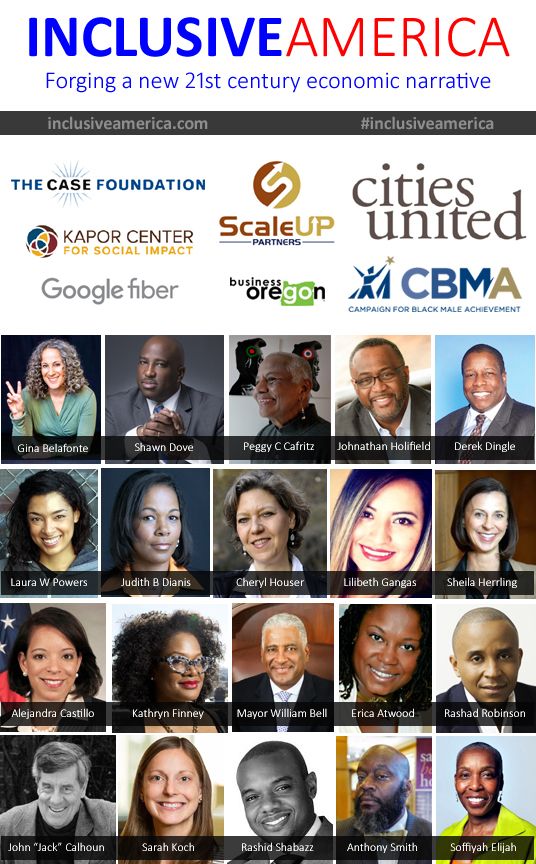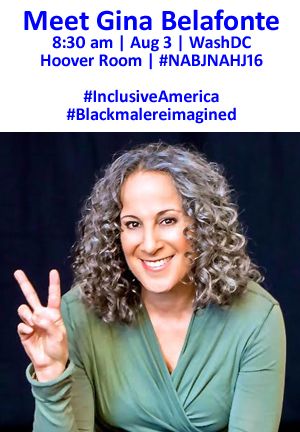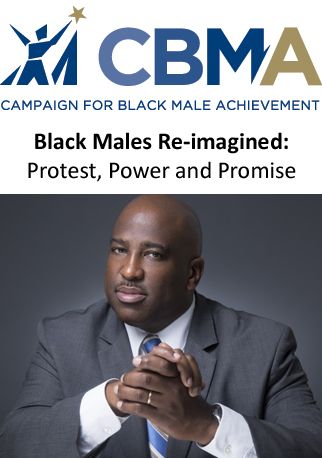
History is often made in relative silence. That was just the case on Aug. 3 in Washington, D.C.
None of the nearly 4,000 journalists of color gathered in Washington DC on Aug 3-7 for the largest convention of black and Hispanic media professionals in the nation (#NABJNAHJ16) could’ve known they would witness a transition point in American history. Although presidential candidate Hillary Clinton made a late-scheduled appearance on Friday, disrupting the regularly scheduled agenda of sessions, the Secretary’s policy remarks scarcely made news.
Unbeknownst to most attendees, the historic moment actually occurred on the opening day of the four-day conference, when a small group of committed philanthropic and corporate leaders, led by the consulting group ScaleUp Partners, presented a full day of programming titled, “Inclusive America: Forging a New 21 Century Economic Narrative.”
More than two dozen notable speakers presented extraordinary insight through a day-long agenda with a mission:
- “Mothers of the Revolution” (Film preview)
- Black Males Re-imagined: Protest, Power & Promise (Campaign for Black Male Achievement)
- Media Imagery & Valuing Black Males: Addressing Structural & Physical Violence (Cities United)
- Inclusive America: Reaching Beyond the Margins (Alliance of Families for Justice)
- Game-Changing Entrepreneurship: “Generation Startup” (Film by co-director Cheryl Houser)
- Inclusive Competitiveness®: A 21 Century National Economic Imperative (ScaleUp Partners)
- The Changing Face of Entrepreneurship (The Case Foundation)
- Inclusive Entrepreneurship (The Case Foundation)

Entrepreneurship was the overarching theme of the Inclusive America forum, presented as a national investment in a new solution to the historic economic plight of black and brown Americans. With the question looming of who will create the jobs of tomorrow, the answer proffered over and over throughout the day was evident: black and Hispanic entrepreneurs represent the fastest rate of entrepreneurial growth in the nation. Investing in their success will produce more jobs.
The challenge for these populations, and the country, is scaling up their existing entrepreneurial activity and channeling it toward industry sectors that are growing. The result would be greater business productivity, job growth and improved contribution to GDP from black and brown sectors of society. This new economic impact would bolster America’s overall global competitiveness. Entrepreneurship, in particular high-growth scalable enterprises, represents a solution to the economic challenge of the 21 century: Who will create the jobs of tomorrow?
The Inclusive America forum opened with recognition of the current tumultuous circumstances of the nation. A preview of the film, Mothers of the Revolution, led into the opening keynote by Shawn Dove, CEO of the Campaign for Black Male Achievement. The documentary deals with the experiences of black mothers who lost their adult children to violence, including those killed by police. The initial focus on conflict occurring across America, which has given rise to protests like Black Lives Matter, Ava DuVernay’s Black Out for Human Rights, and Gina Belafonte’s celebrity-infused Sankofa Music Festival, paved the way for a day filled with optimism and a clarion call for a national vision of Inclusive Competitiveness® by Johnathan Holifield, a former NFL athlete who is now the nation’s premier strategist of innovation-based economic inclusion and competitiveness. Holifield is author of the upcoming book, The Future Economy and Inclusive Competitiveness.

BLACK ECONOMICS MATTER TO WHITE AMERICA
The timing of the Inclusive America forum at the #NABJNAHJ16 convention could not have been more perfect. In the days following the introduction of Inclusive America, news of a nation historically divided by economic and social policies and practices would become the focus of dominant media influencers.
On Aug. 8, The Nation magazine published a provocative piece titled, “The Average Black Family Would Need 228 Years to Build the Wealth of a White Family Today: Just as past public policies created the racial wealth gap, current policy widens it.” That article analyzed an economic data report released by the Institute for Policy Studies (IPS) and the Corporation For Economic Development (CFED).
“They looked at trends in household wealth from 1983 to 2013—a 30-year period that captured the rise of Reaganomics, expanded international trade and two major financial crashes fueled by bubbles in the tech sector and housing prices. The authors found that the average wealth of white households increased by 84 percent during those three decades, three times the gains African-American families saw and 1.2 times the rate of growth for Latino families.
If those trends persist for another 30 years, the average white family’s net worth will grow by $18,000 per year, but black and Hispanic households would only see theirs grow by $750 and $2,250 per year, respectively.
“[Economist] Thomas Picketty said that, left uninterrupted, we would move toward a hereditary aristocracy of wealth,” says Chuck Collins, one of the study’s authors. “What he didn’t say is that in the United States, that would be almost entirely a white aristocracy of wealth.”

The open secret in America is that wealth, largely measured by net worth (not merely income), isn’t the natural outcome of a quality education and a high-wage job, both of which are denied to most nonwhite Americans. The reality is business ownership, productivity, growth and wise investments over time creates wealth. The entire 20 century was spent building wealth for white Americans while denying opportunities for black, Latino and other nonwhite Americans. For the benefit of the country, we must change that dynamic in the 21 century.
Today, the inordinate focus by lobbyists on manipulating government policies to create optimum conditions for business is due to the realization that jobs and prosperity are produced through the process of growing businesses. In their storytelling, journalists should consider the notion that nonwhites can, and should, participate in the process of business and job creation, and contribute to the growth of the U.S. economy. Nowhere in media is this issue being discussed. But it was initiated at the Inclusive America forum presented at the largest convention for journalists of color in the country.

MAKING AMERICA INCLUSIVE
In every presidential election, the top concerns of the voting electorate are the economy and jobs. This race between Secretary Hillary Clinton and Donald Trump is no exception.
But the implication of any suggested plan to accelerate our economy has ignored the reality that the vast majority of business productivity and job growth is currently produced by white Americans, in particular white males.
This standardized system of the American business landscape is the outcome of an obsolete and unsustainable form of capitalism that was built on a foundation of white supremacy and privilege.
Today, any discussion of maintaining the status quo from a bygone era ignores the fact that the demographic shifts due to the growth of nonwhites require the nation to be cognizant of preparing and equipping this talented landscape to fully participate in the economic process. The effort already exists among nonwhite Americans, who are struggling to be included in the process of business creation and competitive in the markets. The challenges are the barriers to entry that have long prevented these groups from succeeding en masse in America.
But there’s also another critical reason why white America must tear down the wall that was built generations ago and sustained to this very day. White Americans are struggling. They are struggling to carry the heavy burden of an economy that was designed to largely depend upon their productivity. And as their entrepreneurial activity and business productivity decreases, and the economic system continues to channel most of the wealth of the nation into the hands of a tiny group of white Americans, the white American middle class finds itself shrinking. The outcome of that shrinkage is creating catastrophic conditions.

SAVING WHITE AMERICA
On Aug. 12, The Atlantic published a report produced in partnership with ProPublica that delved into a mostly unknown history of poor whites in America, back to the arrival of the first settlers. The report focused on the economic despair of white Americans today, which has resulted in skyrocketing rates of opiate drug abuse and mortality (including suicide). The analysis, titled, “The Original Underclass: Poor white Americans’ current crisis shouldn’t have caught the rest of the country as off guard as it has,” centers on two prominent books that delve deep into the history of the economic class system in white America from two different perspectives.
“Two new books—one a provocative, deeply researched history and the other an affecting memoir—are well timed to help make better sense of the plight of struggling whites in the United States. Both accounts converge on an important insight: The gloomy state of affairs in the lower reaches of white America should not have caught the rest of the country as off guard as it has—and mobilizing solutions for the crisis will depend partly on closing the gaps that allowed for such obliviousness.”
White America is in trouble. And with the growing demographics of nonwhites moving the nation toward a majority population of minority groups, all indicators point to the fact that empowering underrepresented groups to be more productive would bolster the U.S. economy and benefit the nation as a whole.
The exclusive privilege enjoyed by white America for centuries is coming to a predictable close, as the analysis by the Atlantic and Pro Publica concludes. It is time for America to transition away from the exclusionary policies and practices of the past toward a future landscape of economic inclusion that empowers others to build wealth and contribute to the global competitiveness of the country.
DEVELOPING SHARED PROSPERITY
Of course, closing the wealth gap is fraught with challenges, and even opposition from those who seek to return to a nostalgic era in the past when the bubble of privilege enveloping white Americans meant they didn’t have to be concerned with, or knowledgeable of, the extreme struggles of nonwhites seeking to participate in the American Dream. Today, the process of building wealth in America needs an overhaul and an extended path of access to those who have been denied access for generations.

Too often the discussion of wealth is diluted with the notion of income inequality, which is also steeped in the history of Jim Crow and the legalized separation of the nation into disparate black and white Americas in 1883 by the Supreme Court. Disparate access to wealth-creating opportunities has long been reinforced by societal practices in white America across all industries, including education. Household income data don’t equate to household wealth, which looks at the net worth of individuals and families and holds an inherent capacity to financially uplift the next generation.
Today, the stakes are too high to sustain the antiquated system of economic oppression and depression of nonwhites. White Americans need the rest of the nation to contribute. And the rest of the nation needs white Americans to dismantle the systemic institutional biases that depress the rise of others. As we look toward becoming an Inclusive America, we cannot move forward in this discourse without revisiting the path that brought us to this place in time.
20 CENTURY ECONOMIC EXCLUSION
The ability for black and Latino families to build wealth in the 20 century was stunted at every turn by systemic institutional biases that didn’t change with acts of congress and changes in law … even when the law was the highest in the land. Unemployment rates for black Americans have always been at least twice that of white Americans. Businesses built by black entrepreneurs in the early to mid-20 century were not supported by white patrons as a rule, and too often when they succeeded (in spite of the institutional barriers) they faced the scourge of white riots that destroyed them.

In the late 20 century, laws were leveraged to target black and Hispanic populations disproportionately with police enforcement procedures and lengthy prison sentences that disenfranchised millions and their families. This hearkened back to the early 20 century Black Codes that relegated black Americans to low-wage job opportunities and Convict Leasing laws representing another form of slavery that trapped black males and further eroded the core of black families.
Changing history is hard, especially the history of a nation built upon an economic class system wherein black people were not only at the bottom, but actually considered subhuman property to be owned by whites for many generations.
One hundred years following the outbreak of Civil War in America, Dr. Martin Luther King stood on the Washington Mall decrying the extraordinary depth of economic degradation of the black American. Most white Americans are aware of Dr. King’s famous “I Have a Dream” speech. Yet, how many will recognize the first refrain of that speech featured early on in its delivery?
“But one hundred years later, the Negro still is not free. One hundred years later, the life of the Negro is still sadly crippled by the manacles of segregation and the chains of discrimination. One hundred years later, the Negro lives on a lonely island of poverty in the midst of a vast ocean of material prosperity. One hundred years later, the Negro is still languished in the corners of American society and finds himself an exile in his own land. And so we’ve come here today to dramatize a shameful condition.”
Indeed, it was a shameful condition to live under the oppressive regimes of political leaders, corporate overlords and white supremacists, whose control over every industry of influence and power dictated the limited confines of a quarantined black America.

In 1965, the Department of Labor published a blockbuster report, “The Negro Family: The Case for National Action,” which focused on the extreme economic and social conditions of black Americans. The report offered two profound statements that have been lost in the noise of the past 50+ years in which the nation’s economy has shifted from industrial manufacturing to a knowledge-based tech-driven, globally competitive innovation economy.
In this new period the expectations of the Negro Americans will go beyond civil rights. Being Americans, they will now expect that in the near future equal opportunities for them as a group will produce roughly equal results, as compared with other groups. This is not going to happen. Nor will it happen for generations to come unless a new and special effort is made.
There are two reasons.
First, the racist virus in the American blood stream still afflicts us: Negroes will encounter serious personal prejudice for at least another generation.
Second, three centuries of sometimes unimaginable mistreatment have taken their toll on the Negro people. The harsh fact is that as a group, at the present time, in terms of ability to win out in the competitions of American life, they are not equal to most of those groups with which they will be competing. Individually, Negro Americans reach the highest peaks of achievement. But collectively, in the spectrum of American ethnic and religious and regional groups, where some get plenty and some get none, where some send eighty percent of their children to college and others pull them out of school at the 8th grade, Negroes are among the weakest.
The most difficult fact for white Americans to understand is that in these terms the circumstances of the Negro American community in recent years has probably been getting worse, not better. Indices of dollars of income, standards of living, and years of education deceive. The gap between the Negro and most other groups in American society is widening.
In 1965, the gap between white and black Americans was widening. It still is today, more than 50 years later. The sad reality is this government report professed the ugly sins of white America and declared the need for a new and special national effort to uplift black America. The vast majority of white Americans did not respond positively.
The report recognized the circumstances of black America were dire, and that those circumstances would not change unless white America changed the systems that created the problem. The report acknowledged the scourge of racist policies and practices that would continue to impact generations unless disrupted. And it openly declared the gap between white and black America was growing. We are still grappling with the same problems today that the country was dealing with in 1965 due to the unwillingness of the nation to address ingrained issues of white supremacy that dictated policies and practices.

That was 50 years ago. Those circumstances and the need acknowledged then are the same circumstances and need that we need to acknowledge today. There was no new and special national effort developed in the wake of this report. Instead, white Americans used the report to blame black Americans for their own plight. The claims then mirror the claims today, with many white Americans declaring the economic troubles of black Americans were due in large part to the out-of-wedlock birth rate and unruly children raised without fathers. Yet, in in 1960, the vast majority of black families were intact, even after suffering through nearly a century of domestic terror and extreme hostility from every corner of society.
But now we have yet another opportunity to address past wrongs and transition the nation away from obsolete policies and practices of exclusion. Today, the vision of an Inclusive America built on the economic foundation of Inclusive Competitiveness® can be the future we present to generations of Americans who will live in a multicultural society. That’s a new national effort in which we can all invest.
DESTINIES INEXTRICABLY TIED
Fifty years ago, black Americans were largely prevented from participating, much less contributing and competing in the industrial manufacturing economy due to systemic factors controlled by white America, which absolved itself of any responsibility to rectify the shameful condition it created. King acknowledged in his speech in 1963 during the March on Washington that by their presence some white Americans were in support of the struggles of black Americans:
“The marvelous new militancy which has engulfed the Negro community must not lead us to a distrust of all white people, for many of our white brothers, as evidenced by their presence here today, have come to realize that their destiny is tied up with our destiny. And they have come to realize that their freedom is inextricably bound to our freedom.
We cannot walk alone.”
We simply cannot escape the need to come to terms with our past, if future generations of Americans – black, white and all – are to have any hope of enjoying a land of inclusive opportunity and prosperity.
Today, white and nonwhite Americans are suffering to varying degrees. It is time to tear down the white wall and open the landscape to an Inclusive America wherein we work together to ensure all citizens are empowered to reach their highest potential and pursue their dreams.

AMERICA IN TRANSITION
The economic impact reports on both black and white Americans, published by last week by two credible mainstream media organizations, point to a current economic crisis impacting both landscapes of a divided nation. The results of this division and angst among Americans, both white and nonwhite, are playing out in the national discourse around presidential politics.
On Aug. 3 in Washington DC, ironically at a conference of journalists of color, media missed the historic emergence of an effort aimed toward dismantling the wall of exclusion erected long ago and building an Inclusive America. We can correct that oversight today.
Inclusive America was launched by those who seek to create coalitions of like-minded leaders across the landscapes of corporate, philanthropic, government, education, community and economic development. These efforts focus on economic empowerment of underrepresented Americans, which include women, minorities and rural regions where poor whites are also disconnected from access to tech-innovation ecosystems that are instrumental in the growth of business productivity, jobs, wealth and regional competitiveness.
For the nation to successfully transition from the pre-Obama era of economic exclusion to a post-Obama Inclusive America landscape, a national discussion on empowering others to be more productive and competitive in a global innovation economy is paramount.
Let’s start the conversation with the focal point of investing in inclusive entrepreneurship, and discuss why Inclusive Competitiveness is a 21 century national economic imperative and the first step toward building an Inclusive America.
Learn more about Inclusive Competitiveness as a framework around which we can build an Inclusive America for all by visiting InclusiveAmerica.com, and join a new national effort to rebuild America for the benefit of all Americans.
